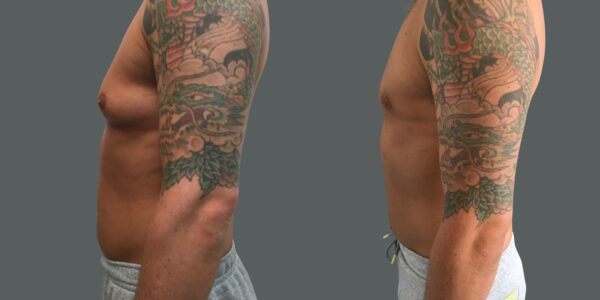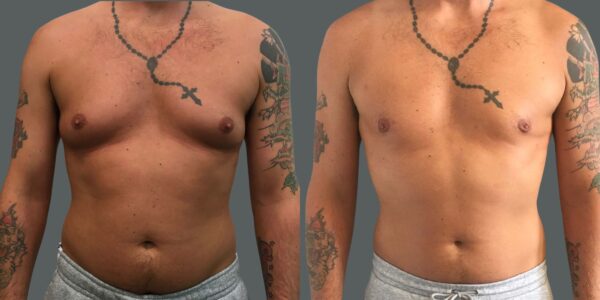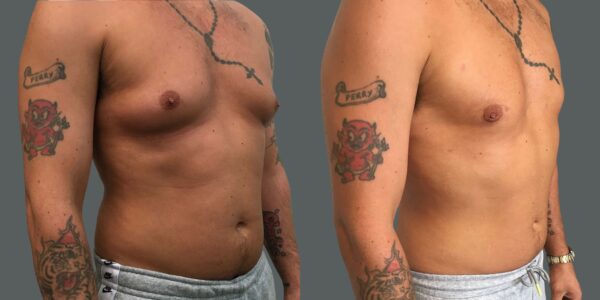

If you have been dealing with enlarged breasts, the chances of you being one in a million are slim. The reality is that gynaecomastia is more common than many people realise. It also currently affects a large number of men around the globe, with several well-known celebrities reportedly dealing with the condition. These include Dwayne “The Rock” Johnson, Arnold Schwarzenegger, and Jack Black. In fact, among men aged 50 to 69, up to 65% may have some degree of gynaecomastia. In adults, around 35% of men are affected. And during puberty, up to 70% of teenage boys may experience gynaecomastia. In the UK, it is estimated that around 3 to 6 in every 10 men will experience some degree of gynecomastia at some point.
Derived from the Greek words gynaikos (meaning “woman”) and mastos (meaning “breast”), enlarged male breast tissue is usually harmless, but it can lead to emotional and psychological challenges. The good news is that gynaecomastia correction surgery offers an effective way to remove excess fat and glandular tissue. It has also become one of the most common cosmetic procedures for men worldwide. If we look at the numbers, in 2022 alone, over 18,000 men in the United States underwent surgery for gynaecomastia, according to the American Society of Plastic Surgeons (ASPS). In India, approximately 29,532 gynaecomastia procedures are performed annually.
Thanks to significant advances in modern surgical techniques, this procedure is relatively straightforward, safe, and effective, offering natural-looking results.



It can affect men of any age. It is estimated that roughly 40 to 60% of men are affected by the condition at some point during their lifetime.
While most cases in teenagers vanish spontaneously within a few years, in others, the condition persists or reappears later in life. Many men start to seek surgery because they experience physical discomfort or tenderness in their chest area. Others are concerned about the overall appearance of their chest and may even start to avoid social contact because of it.
But what causes gynaecomastia? It is most commonly caused by a hormonal imbalance. Typically between the amount of oestrogen, which stimulates breast tissue growth, and the amount of testosterone in the body, which helps suppress it.
Of course, several other factors can disrupt this delicate hormonal balance. One of them is ageing. Simply because our testosterone levels tend to decline as we age. It is a completely natural part of growing older and life. Not to mention, when this decline is combined with weight gain or certain medications, it can further exacerbate the development of enlarged male breast tissue.
Medications like anabolic steroids, anti-androgens, antidepressants, anti-anxiety drugs, and ulcer and heart medication have all been found to cause gynaecomastia. Naturally, certain health conditions may also have an impact. Medical concerns like liver disease, kidney failure, hypogonadism, hyperthyroidism, and hormone-related tumours can wreak havoc on your hormones.
Lastly, obesity is also a major factor as excess fat can raise your oestrogen levels, contributing to the development of glandular breast tissue. However, it is important to note that men who are not overweight may still develop excess fat or glandular tissue in the chest area.
In the early 20th century, treatments were limited, and most carried some sort of risk. Open surgical excision, a popular method at the time for removing tissue, was quite effective. However, it was also an invasive procedure that often left noticeable scarring.
Naturally, as surgical techniques and anaesthesia improved throughout the decades, so too did the outcomes. In the 1980s, liposuction emerged. And it was considered a revolutionary treatment for gynaecomastia. Liposuction, however, was not enough on its own to address thick glandular tissue and severe male gynaecomastia.
Today, male breast reduction surgery is typically performed under general or local anaesthetic and is not very invasive (depending on the severity). It also comes with an excellent patient satisfaction rate. To such an extent that, according to numerous studies, over 90% of patients experience high satisfaction levels following surgery. A modern approach to correcting oversized male breast tissue now involves combining various sculpting techniques to achieve a flatter, firmer, and more muscular chest and appearance.
At 111 Harley St., a tiny cut is made around the areola (the darker area around the nipple) to remove excess breast tissue. In less severe cases, liposuction is used to minimise scarring, as it gently sucks out the excess fat and glandular tissue. For more significant breast enlargement, both techniques may be combined.
The key is to remember that enlarged male breast tissue affects thousands. But it is treatable thanks to advancements in surgical techniques. Growing awareness has also allowed increasingly more men to seek and access treatment.
Regardless of why your male breast enlargement occurred, whether due to hormonal changes or imbalances, medications, lifestyle choices, or underlying conditions, it can be successfully treated with customised precision, surgery, and care.
Therefore, if the condition is affecting you physically, emotionally, or socially, talk to a trusted surgeon about it.

Dr Yannis Alexandrides MD FACS is an expert in facelifts and cosmetic surgery and is the Founder and Medical Director of 111 Harley St.